Mail 2.0
Mail was one of my original favorites of OS X, although the application itself looked extremely simple. It quickly proved to be much more robust and much less of a resource hog than my previous client, Outlook. As one of my favorite applications under OS X, I was curious to play with Mail 2.0 in Tiger, which has had a handful of changes.When starting up Mail for the first time, it will take a few minutes to import all of your old emails into the new version of Mail.
The most noticeable change in Tiger is that Mail has a brand new interface. The new interface is strange - I'm not totally sure what Apple's trying to do with it. It looks good, but it definitely stands out from the rest of the OS. Although the look and feel of Mail has changed, the icons haven't really, which makes them feel somewhat out of place in this new version. I may get used to them over time, but at this point, I'm not. The new top toolbar is quite possibly one of the biggest positive visual improvements to Mail over its predecessor.
Mac OS X Panther Mail
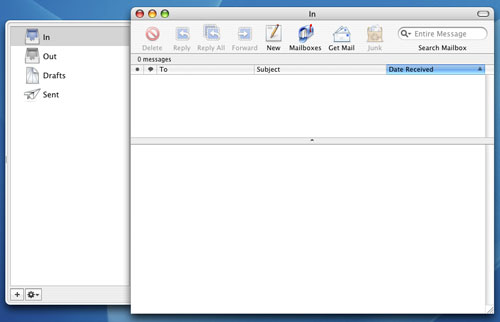
Mac OS X Tiger Mail
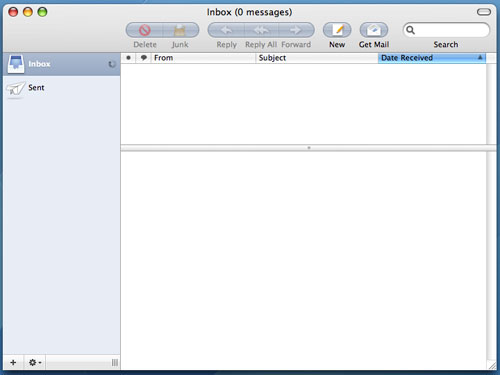
There are smaller interface changes that are nice, such as the new save attachment button. The new button is a lot cleaner/simpler looking now, mostly because it's small. It's a minor change, but I like it.
Mac OS X Panther - Mail Save Attachment button
Mac OS X Tiger - Mail Save Attachment button
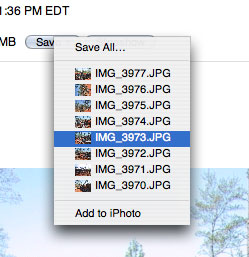
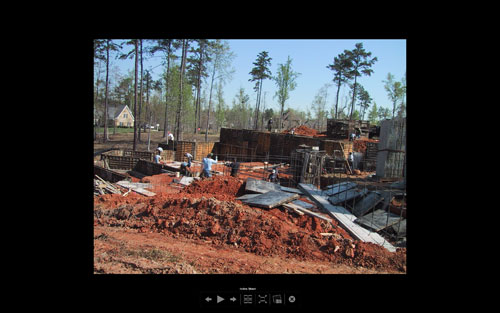

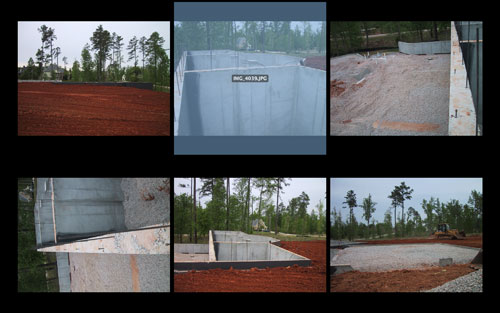
The other major changes to Mail are Spotlight related, as all searching in Mail 2.0 is driven by Spotlight. This comes as a huge relief to me as I found Mail's original search to be fast, but lacking in accuracy, not to mention that it was a pain to switch between the fields that I was searching. With Mail 2.0, searching is infinitely more useful. First of all, you no longer have to select where you want to search from a drop-down list. As soon as you start a search, a bar appears that lets you select where to search, and what to search. Unfortunately, searching the "Entire Message" still doesn't catch items that are only in the Subject field and you can't select both, which is a bit of a pain. You can also save your searches as Smart Mailboxes, which are similar to the Smart Folders in the new Finder.
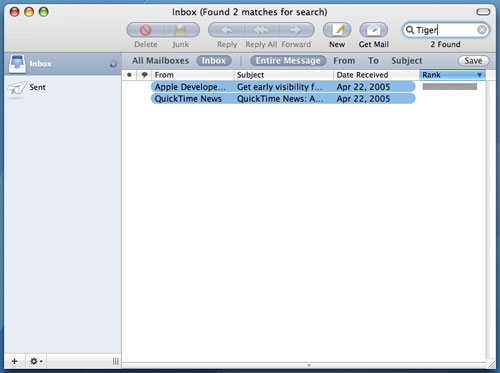

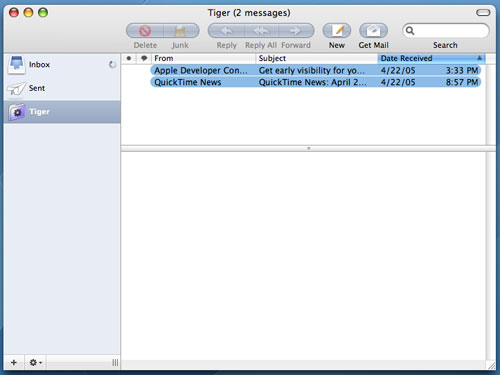
Smart Mailboxes, on the other hand, aren't actually physical Mailboxes - they are just saved searches (much like Smart Folders). So in this case, Smart Mailboxes do still allow the new mail notifier in the Dock to be triggered by manufacturer emails coming in. The downside is that my Inbox doesn't remain as clean and uncluttered. But with a large number of Smart Mailboxes, I could theoretically get things to the point where I'd rarely have to check my main Inbox for email. It's something I still have to play around with more at this point, but the flexibility of Smart Mailboxes is definitely appreciated.
There are other minor functionality tweaks to Mail 2.0, such as a new compose window. When composing emails, you now have the option of adding new fields directly from the compose window, such as a Bcc address field or a Reply-To address field. Also, hitting Command + i in Mail 2.0 now brings up an Account Info pane that will give you a list of all messages on your mail server, as well as let you customize mailbox behaviors. It's a neat panel that can be useful if you have your machine set to leave your POP email account messages on the server for a certain period of time.
Overall, I'd say that Mail 2.0 in Tiger is a reasonable improvement, but mostly because of the features that Spotlight offers. The addition of the slideshow viewing mode is also useful, but the interface tweaks aren't anything to get too excited about in my book. In some cases, I preferred the old, simpler look of Mail, while in others, I welcome the new client. In the end, it still does the same great job that it always did; it's just that now, I can search a lot better and it's easier dealing with pictures in emails.










55 Comments
View All Comments
melgross - Sunday, May 1, 2005 - link
#21 With all that you said, you didn't really say very much.Yes, it's true that Apple is mostly a hardware company. They will sell "only" a billion dollars of software this year.
But what you forget is that every Mac that sells takes away a sale of a copy of Windows from MS. Apple will sell more that a million more computers this year than they sold last year. That's over a million fewer copies of Windows sold. As well as less copies of windows software by MS and others. It also means more copies of MS Office for the Mac sold.
It's just dumb talking about "balls". This is a business. Maybe you like to play chicken, but companies that like to stay in business don't.
Perhaps if Apple licensed the Mac OS to MS both times when MS came knocking on their door life would have been different. :)
michael2k - Saturday, April 30, 2005 - link
#21: If anyone compares Longhorn to Tiger, it's because Microsoft has decided it's a valid comparison:http://insight.zdnet.co.uk/software/0,39020463,391...
Allchin has made public comments regarding Tiger, when talking about Longhorn.
On a technical level, Longhorn is implementing many of the features that Tiger, Panther, and Jaguar have, so comparison is unavoidable:
Avalon vs Quartz
Metro vs PDF
DB/WinFS vs Spotlight/HFS+
etc
Eug - Saturday, April 30, 2005 - link
#20: "So while Apple keeps braying to the moon about "Longhorn" I, on the other hand, am content to wait until Longhorn actually ships before making any sort of comparisons as I would prefer any comparisons that might be made to have some *meaning*...;)"Uh... I should point out that the Apple Mac OS X pages don't have a single reference to Longhorn anywhere, AFAIK.
Ocaid - Saturday, April 30, 2005 - link
The fact, "Jack", is that this is marketing and Apple does make nice hardware and a great OS for some people. And I do agree with some of your salient points. But for a company that "is not a direct competitor to MS", some of you guys sure seem to worry a lot about them.WaltC - Saturday, April 30, 2005 - link
I completely fail to understand this comparison with Longhorn...;) I mean, at one level I do understand it all too well--Apple PR, while completely ignoring Windows x64 as if it does not exist, enjoys boasting that it has "beaten" Longhorn out of the starting gate as a "64-bit" OS--but really this is just so very lame and completely transparent. Apple has always had an exquisite case of tunnel vision when it comes to picking and choosing what it will compare its products to...:DSo this whole "Longhorn-Tiger" comparison is so predictible and infantile (as Tiger is shipping and Longhorn isn't--so nobody has a clue as to what Longhorn will be when it actually does ship a year or two from now) and right on par for Apple PR. So typical of Apple to compare its products with products that aren't shipping--wow, how much "safer" can you can get than that? So while Apple keeps braying to the moon about "Longhorn" I, on the other hand, am content to wait until Longhorn actually ships before making any sort of comparisons as I would prefer any comparisons that might be made to have some *meaning*...;)
In this vein, I also wish that people would wake up and realize that Apple and Microsoft are not now direct competitors and never have been...;) Microsoft is software company--Apple is distinctly a hardware company--and the old saw in the industry is that the highest and best purpose for *any* Mac OS is that it serves as a dongle to protect and promote Apple's hardware sales.
The classic mistake that I see so often is this misunderstanding that Microsoft and Apple somehow compete in the same markets--not true. Apple's competitors in reality are companies like Dell, etc., who--unlike Microsoft--make better than 90% of their net income from hardware sales. It's pretty simple, really, as >98% of Microsoft's net income is from the sale of software exclusive of hardware. The difference is so vast I am surprised it is so often overlooked. And yet it is...
For instance, if Apple would decide to undertake to write an OS for the same x86 hardware standards that Microsoft does (Intel/AMD promulgated standards, mainly) *then* we could call them competitors with a straight face since they'd be competing for share in the same hardware markets. But the simple fact is that Microsoft doesn't even *make* the computers which run its OS's (and so of course cannot and does not profit directly from such hardware sales); but an Apple OS, on the other hand, is totally useless in the absence of an Apple designed-and-sold computer to run it. The enormous differences ought to be clear as daylight to everyone.
Basically, the concept that an Apple OS is any sort of direct competition to a Microsoft OS is purely a wishful and irresponsible--not to mention inaccurate--fantasy. That's why talking about Apple's <3% share of the annual world-wide *desktop* computer market (which is far, far less in the exclusive server markets, or higher in the notebook markets, etc.)is somewhat of a bogus comparison in the first place. MS OS's serve "everybody else" apart from Microsoft (eg, Dell and the thousands of other companies manufacturing x86 PCs and components exclusive of Microsoft) while Apple's OS's serve only Apple-branded hardware exclusively. I am always surprised as to why this salient fact of the matter is so often ignored. But there it is...
I'd love to see Apple competing directly with Microsoft in the much larger hardware arena of x86 platforms and standards--I would welcome the competition. But I honestly don't think Apple can compete in that market--and I believe that's exactly why Apple doesn't even try. I'd love to see Apple offer its own Apple-branded x86 PCs along with an Apple x86 OS which would run on "everybody else's" x86 box just as Microsoft's OS's currently do--but I'll tell you right now that I'm not going to hold my breath waiting on that to happen as I don't believe it ever will. Frankly, I don't believe Apple has either the balls or the brains or the will to do it--and that's the fact, Jack...:D
michael2k - Saturday, April 30, 2005 - link
#11: Obviously the article is not meant for you then. Does it occur to you that there are other reasons to use computers than play games? Video games are not the end all and be all of the computing experience.HansZarkow - Saturday, April 30, 2005 - link
Repeatedly reading about how buggy Tiger is makes me wonder, why Apple pushed the release. Panther was doing alright and Apple is generally rather thorough when it comes to that.I think Tiger was originally to be released in 2H05 around the same time that Longhorn was scheduled. Then Microsoft pushed the release date back a year. Now Apple faced the situation that they couldn't release 10.5 only a year after 10.4.
So not only wouldn't they be able to react to some features that Longhorn might bring along, but they would also leave Microsoft an undistored PR-window where they would be mere spectators.
Hence, Apple rushed the Tiger-release to 1H05, approximately 18 months after Panther. That gives them another 18 months to fine-tune 10.4 and come up with an answer to every feature that Longhorn might pack.
It's the price of being Apple, the (self-proclaimed) technology-leader, they can't let Microsoft talk about the (possible) advantages of Longhorn for half a year.
This makes sense from a PR point-of-view, but it is definetly unfair to the people buying 10.4 because I doubt it will see its full potential before 10.4.3
vailr - Saturday, April 30, 2005 - link
#13: Not correct! My 3.2 GHz P4/WinXP machine can run PearPC/MacOSX 10.3.9, with "About this Mac" info indicating that it's a "Mac G3 running at 1.32 GHz".So, would be interested to see whether: WinXP64/PearPC/MacOSX 10.4, running on an "upper echelon" AMD64 chip could compete, speedwise, with OSX Tiger, running on native Mac hardware?
jasonsRX7 - Saturday, April 30, 2005 - link
I don't know if it's just because I'm more used to it, but I still like Quicksilver better than Spotlight. I find QS to be faster and more functional. Maybe Spotlight just needs to grow on me some more.DerekWilson - Saturday, April 30, 2005 - link
#15 ... is that a joke (and coincedence) or an attempt to bring up the legal suit being brought against Apple by Tiger Direct for the use of the Tiger name?Haven't kept up with that much myself -- though it did seem fishy that they waited until this week to bring up the issue.
http://apple.slashdot.org/article.pl?sid=05/04/28/...